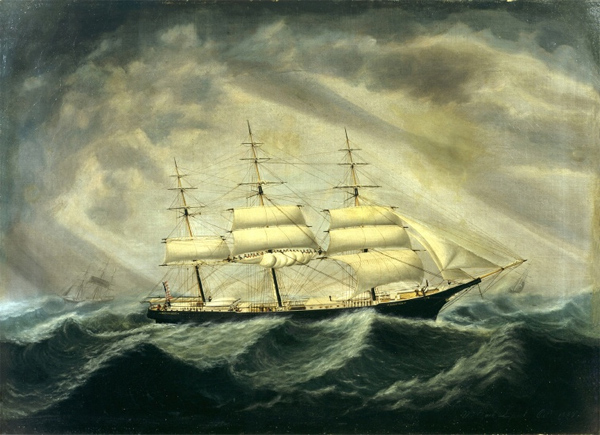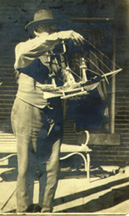Clipper Ship "Flying Scud"
» Click here for more information on the "Cestrian" and the Pickering family

Clipper Ship Flying Scud in a Gale
by artist, William G. Yorke (1817-1893 c.)
Oil on Canvas
25 3/4” x 36 1/4” (65.4 cm x 92.1 cm)
Signed: “Wm York L.pool Octr 1859”

Charles William Pickering
[1841-1928] holding the
model of the ship, Cestrian
______________________________
Extreme clipper ship built in 1853 by Metcalf & Norris, Damariscotta, ME. Dimensions: 221'×41'×23' and tonnage 1713 tons OM.
1853 November 2
Launched at the shipyard of Metcalf & Norris, Damariscotta, ME.
1854 [?]
Sold in New York for $100.000 to parties in that city.
1854 March 23
Sailed from New York under command of Captain Patten for Liverpool where she arrived after 29 days.
1854 September 28
Sailed from New York under command of Captain Warren Bearse, Hyannis, for Melbourn where she arrived after 80 days. Sailed 449 miles on November 6 and covered a distance of 4620 miles during a period of 16 days.
1856 March
Captain Rodney Baxter, Hyannis.
1856 April 14 - July 4
Sailed from New York to Bombay in 81 days.
1859 September 26
Arrived at Liverpool 92 days from Bombay.
1861 February 5 - May 15
Sailed from Whampoa to New York. Was struck by a whirlwind on May 4 at 25°N, 66°40'W which carried away all three topgallant masts with the furled sails and all sails set except for the spanker.
1861 November
One eighth share of the ship was sold for $3500.
1862 February 28 - June 27
Sailed from New York to San Francisco in 188 days.
1863 April
Sold to J. Thompson, Liverpool, and was renamed Cestrian.
1865-1871
Listed as being owned by G.H. [Charles William Harrison] Pickering, Liverpool.
About the "Flying Scud"
This is among the earliest known dated paintings by William G. Yorke. It shows the Americn clipper ship Flying Scud in a gale with many of the crew up on the main yard actively engaged in furling the main course.
The ship is still pressing forward on port tack under reduced canvas while smaller ships in the background have also reduced sail significantly to cope with the gale.
This painting is in the votive style with the shaft of light suggesting a protective divine presence. Built for speed; Flying Scud still holds the New York-Marseille record (19 days 20 hrs. set in 1856). Many additional speed records attributed to her are disputed. Noted on her maiden voyage as having 'amazing and phenomenal speed'; she consistently made fast passages. However; it seems that for a variety of reasons many of her records could not be verified. This includes the report of a remarkable noon to noon run of 460 nautical miles; sustaining an average speed of 19.5 knots. Her fastest reported noon to noon run was 449 nautical miles which; although also disputed; still constitutes the all time record.
She was reportedly often overloaded and sailing out of trim. Even so; upon examination of the documented average speeds throughout her career; she is to be considered one of the fastest clippers ever built. She was sold to British interests in April 1863 and renamed Cestrian and went into the England-India service.
She made a voyage from New York to Liverpool; arriving on September 26; 1859 under Captain Rodney Baxter. This was probably when the painting was made to commerate a storm encountered en route.
______________________________________________
AMERICAN CLIPPER SHIPS
1833-1858
by Octavius T. Howe, M.D. and Frederick C. Matthews
Volume I - ADELAIDE - LOTUS
Salem, Massachusetts, MARINE RESEARCH SOCIETY - 1926
Extreme clipper ship, launched from the yard of Metcalf & Norris, Nov. 2, 1853, at Damariscotta, Maine. Length of deck, 221 feet; beam, 41; depth of hold, 23; 1713 tons, old measurement. She was of sharp model, very strongly built and in every way a fine ship. After arrival at New York, from the builder's yards, she was purchased by parties in that city for $100,000, and soon became noted as a fast sailer.
On her maiden voyage, which was rounded between New York and England, the Flying Scud did not realize the expectations of her owners or builders as to speed, due to experiencing much heavy weather outward and homeward. Captain Patted was in command and leaving New York, Mar. 23, 1854, she was 29 days to Liverpool. After return to New York she was chartered for the lump sum of $30,000 for a voyage to Melbourne and sailed, Sept. 28, 1854, under command of Capt. Warren Bearse of Hyannis. When two days out, in the Gulf Stream, she was struck by lightning twice, the first time forward, when several men were knocked down. In the second instance, she was hit between the main and mizzen masts when most of the men on deck were knocked down. The ship was not materially damaged but the needles of the compasses revolved with great rapidity, when was thought due to the iron cargo in the after hold having become magnetized. The ship had to be laid to and thereafter, until Dec. 7th, the compasses had to be used on a board extending 10 feet out from the port side. She crossed the line on Oct. 26th and on Nov. 5th was in 27* 41' South, 29* 30' West. The following day she ran 449 nautical miles. Then for a week had variable weather, calms and strong gales; often logged 15 and 16 knots. Ran her easting down in about 44* South and between Nov. 24th and Dec.10th, made 106* 54' of longitude, the actual distance covered, as figured by Lieutenant Maury, being 4620 nautical miles, an average of 288 miles for the 16 consecutive days. She arrived at Melbourne in 80 days from New York. Then went to Calcutta in 45 Days. Sailed from Calcutta, April 30, 1855, and was 110 days to Liverpool. Arrived at New York, in March 1856, from Marseilles, when Capt. Rodney Baxter of Hyannis, Assumed command, Captain Bearse retiring to take the John Wade.
The Flying Scud sailed from New York, Apr. 14, 1856, and arrived at Bombay, July 4th, in a passage of 81 days. While this run is seven days longer than the record set by the Sweepstakes in 1857, it has otherwise been beaten but seldom and then only by a few days. The Flying Scud continued in trade between England and Indian ports and on Sept. 26, 1859, reached Liverpool in 92 days from Bombay. She then went out to China, returning to New York, where she arrived, May 15, 1861 from Whampoa, Feb. 5th; Java Head, Feb. 22nd; Cape of Good Hope, Mar. 29th; and the equator, Apr. 21st. Captain Harding, who was then in command, reported that after leaving Whampoa he had fine weather, with mostly light winds, until May 4th, during which period had furled skysails only once, in a squall. On May 4th, at 8 P.M., being then in 25* North, 66* 40' West, the ship was struck by a whirlwind which carried away all three topgallant masts with the furled sails; the fore and main topmastheads and the head of the mizzen mast were sprung and the courses, topsails and jibs and the fore and main topmast staysails were blown away. After the squall passed, the spanker was the only sail left above deck.
At New York, in November 1861, a one-eighth interest in the ship was sold for $3500. She loaded for San Francisco and with Captain Harding still in command, sailed from New York, Feb. 28, 1862. The first 2-1/2 days out had hard gales; in 66 hours ran 1053 miles; crossed the line 23 days out; thereafter had light winds nearly all the way, not having to reef topsails until just south of the equator in the Pacific. Arrived at San Francisco, June 27th, after a passage of 118 days. Leaving the port, July 28th, she was 44 days to Valparaiso. Arrived at Liverpool, Mar. 14, 1863, from Cobija.
The Flying Scud was sold a London, in April 1863, and became the British ship Cestrian, of Liverpool, J. Thompson owner. From 1865 to 1871 she is listed as owned in Liverpool, by G. H. Pickering, and commanded by Captain Fotergill and later by Captain McGarrey.